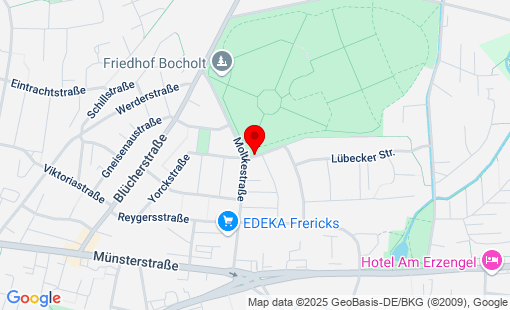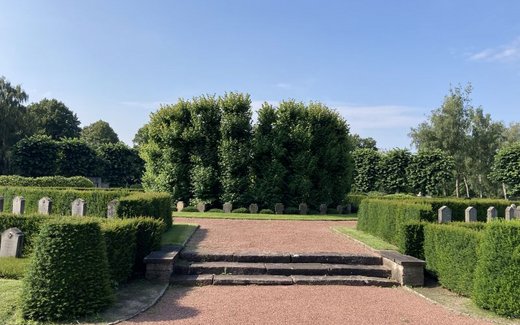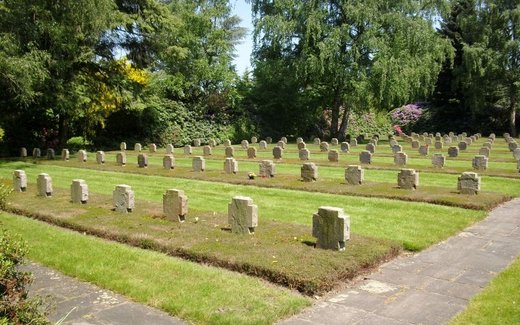Bocholt war cemetery
There are five war cemeteries in Bocholt with a total of 2,580 war dead.
Here in the cemetery of honor of the municipal cemetery rest 84 war dead of the First World War and 742 of the Second World War, including over 40 unknown war dead. The two sites were deliberately brought into a close relationship in terms of design. The Volksbund Deutsche Kriegsgräberfürsorge (German War Graves Commission) redesigned the site of the Second World War in 1955.
On 27 May 1956, the memorial site was inaugurated by District Vice President Dr. Arnold Ottersbach, Münster. A commemoration takes place here every year on Remembrance Day.
Russian war cemetery in Bocholt, Barloer Straße
1.736 Russian prisoners of war died of typhus, hunger and violence in the former "Bocholt city forest camp" and were laid to rest in a separate cemetery on Vardingholter Straße. Only numbers on small stone slabs mark their graves; there is no longer a list of names. They remain nameless witnesses to history.
Data on the history of the "Bocholt City Forest Camp", which is commemorated by a memorial stone:
1935 Establishment of the camp by the NSDAP, Hilfswerk Nordwest (Bad Godesberg), for fugitive Austrian SA men (so-called Austria Legion).
1938 After the invasion of Austria by German troops on March 12, 1938 and the annexation of Austria to Germany, the camp is evacuated; the Legion returns to Austria. Sale of the camp buildings by the NSDAP to the Reich Treasury (army).
27. September: Conclusion of a garrison contract between the town of Bocholt and the Reich Treasury (army). Transfer of ownership of the land for the camp. The camp was used for the accommodation and training of recruits serving on a short-term basis. A shooting range was built not far from the camp and a training area in the Hohenhorst mountains was planned. However, the camp hardly served this purpose.
1939 March 27: the town chronicle records that 2,000 members of the Reich Labor Service (RAD) are temporarily housed in the camp. After the beginning of the Second World War, the camp served as a prisoner of war camp, specifically as a transit camp. In November, the first 400 Polish prisoners of war arrived at the camp, followed by others.
1940 from May: the first prisoners from the Western Front arrived; first Dutch, then Belgians, then French, English, etc. In October, temporary billeting of German troops (6th Company, II Battalion, Infantry Regiment 626).
1941 November 27: the first 800 Russian prisoners of war arrived, followed later by many thousands. The camp was considerably enlarged with emergency barracks.
1944 September. After the landing of British paratroopers in the Arnhem area, Bocholt became part of the rear front area. The POW camp was moved further east. Instead, entrenchment workers for the Westfalen-Wall moved into the camp, later also their rations staff.
1945 March 22 to 25: Accommodation of patients from the destroyed St. Agnes Hospital after the air raid on the city. 30. March: Capture of the camp by British troops. April: After occupation of the town of Bocholt, collection camp for foreign workers, especially Russians, until they are repatriated
1946 September. 2.500 Estonians, Latvians and Lithuanians move into the camp.
1947 January. Jews from the Bergen-Belsen camp (mostly Poles, Hungarians and Romanians) were brought together here in the camp for emigration to Israel.
1950 May. Yugoslavian refugee families arrived at the camp. April. The Ministry of Labor and Social Affairs of the state of NWR took over management of the camp from the British military government.
1951 September. The DP camp (= Displaced Persons, homeless or forcibly displaced foreigners) under German management was closed. However, a number of families remained there until they were rehoused elsewhere.
1952 December. The camp is set up as the main transit camp for refugees from the Soviet zone.
1956 November 21: the first refugees from Hungary, who had left their homeland in the wake of the Hungarian uprising, arrived.
1959 Temporary use of parts of the site by the German army.
1985 Purchase of the camp site by the city of Bocholt for the expansion of the Stadtwald recreational area.
The history of the "Stadtwaldlager Bocholt" is a reminder and a commitment to peace - for all of us!


